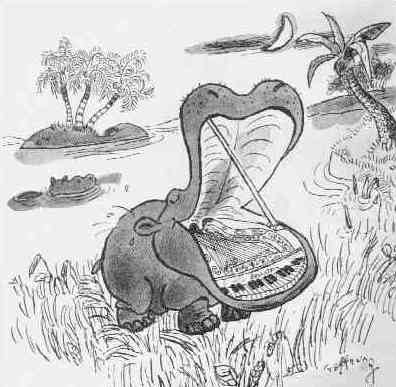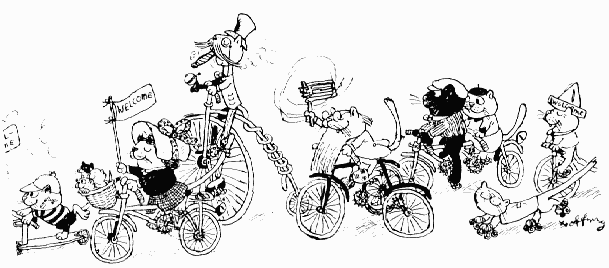
The following year comes Hoffnung's Musical Chairs,
dedicated to his close friend, Malcolm Arnold. This volume is a delight for
animal lovers and opens with a brilliant drawing of an elephant appearing
as part of a gramophone. His trunk is the tone-arm bearing the stylus and
the creature has one ear enlarged to become the horn. By the use of only
three short lines for an eye, Hoffnung bestows a look of benign happiness
on the elephant's face. Other drawings put elephants'
trunks to a variety of uses such as a French horn, a tuba, a trumpet,
an alpenhorn and a cobra for a snake charming elephant. This is the volume
that includes perhaps Hoffnung's best known and loved drawing, that of the
smiling cat playing his stave-like whiskers with a violin bow held with his
tail. An ocarina is shown as a bird having just laid an egg, little whistles
also become birds in trees, a violin case is a spouting whale, tambourines
are transformed into jelly fish with trailing tentacles and a bagpipe becomes
an octopus. This little book ends with a postlude; nine sketches depicting
the erection of a music stand on a concert platform. After a series of skirmishes
the performer emerges victorious, his formal dress awry, bearing a black
eye, a large lump on his head and a bloody finger and thumb, none of which
discourage him from bowing formally and vigorously to an appreciative
audience.
to a variety of uses such as a French horn, a tuba, a trumpet,
an alpenhorn and a cobra for a snake charming elephant. This is the volume
that includes perhaps Hoffnung's best known and loved drawing, that of the
smiling cat playing his stave-like whiskers with a violin bow held with his
tail. An ocarina is shown as a bird having just laid an egg, little whistles
also become birds in trees, a violin case is a spouting whale, tambourines
are transformed into jelly fish with trailing tentacles and a bagpipe becomes
an octopus. This little book ends with a postlude; nine sketches depicting
the erection of a music stand on a concert platform. After a series of skirmishes
the performer emerges victorious, his formal dress awry, bearing a black
eye, a large lump on his head and a bloody finger and thumb, none of which
discourage him from bowing formally and vigorously to an appreciative
audience.
In the publication of Hoffnung's Acoustics, last and
final book of the series, the drawings reach their zenith when Hoffnung explores
the world of musical sound and presents an array of fantastic noises on paper.
A critic of the day wrote in The Times that he felt Hoffnung was on
the verge of pure musical draughtsmanship and a completely uncharted artistic
territory. In a section headed Noises, we are confronted by a cacophony
of sounds; a demure four-note chord and a strident discord sit side by side
on their pages; a nimble, Klee-ish Pizzicato trips gaily across another
page on the toes of its multitudinous pointed feet, all the while plucking
hairs of different musical notation from its head and scattering them around.
A Ping, a Hum, a ravishing Arpeggio and a jagged
Staccato; each cartoon makes its point with exactly perceived precision.
A bursting Crescendo thrusts loudly from its page, followed by a withdrawn
and barely audible, Diminuendo. One really hears the dull thump of
a bass drum as the strange creature called A Thud hits the ground
with a wallop. An Oompah is, of course, a tuba having a good blow
in an alpine meadow and A Rest is the Hoffnung tuba, slippers off,
lying on its side asleep, with its ear-like bell listening out for the alarm
clock.
 Seven pairs of hands, varying in size and
shape from slender filigree, pudgy baby-fingered, tentacular, rectangular,
multidigitate, to simply a pair of mallets wearing cuffs, evoke the exact
sound we would expect each player to produce. There is a wonderful two-page
conjuring-up of A Fugue, depicting an increasingly distraught pianist
imperilling her life to greater degree as she nears the top of an inverted
pyramid of grand pianos. Fortunately, what can only be a disasterous climax
is reached beyond the top of the page. Composers do not escape leg-pulling.
Amongst many, Manuel de Falla as a matador side-steps as a bullish grand
piano enters the Spanish bull ring, while Listz, a circus ringmaster, cracks
his whip at a prancing stallion- grand. The book is a feast for the
imagination
Seven pairs of hands, varying in size and
shape from slender filigree, pudgy baby-fingered, tentacular, rectangular,
multidigitate, to simply a pair of mallets wearing cuffs, evoke the exact
sound we would expect each player to produce. There is a wonderful two-page
conjuring-up of A Fugue, depicting an increasingly distraught pianist
imperilling her life to greater degree as she nears the top of an inverted
pyramid of grand pianos. Fortunately, what can only be a disasterous climax
is reached beyond the top of the page. Composers do not escape leg-pulling.
Amongst many, Manuel de Falla as a matador side-steps as a bullish grand
piano enters the Spanish bull ring, while Listz, a circus ringmaster, cracks
his whip at a prancing stallion- grand. The book is a feast for the
imagination
In the late fifties Hoffnung brought out a larger sized book of non-musical cartoons entitled Ho Ho Hoffnung and an illustrated children's book named The Isle of Cats, written by John Symonds. Hoffnung was passionately fond of cats.

 |
 |
 Return to MusicWeb International
Return to MusicWeb International